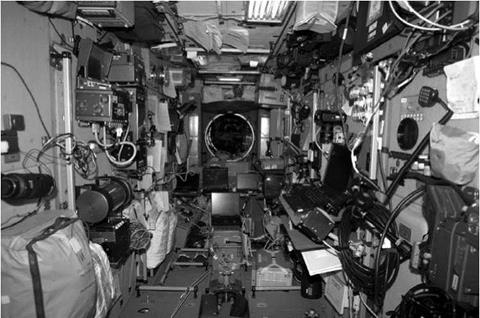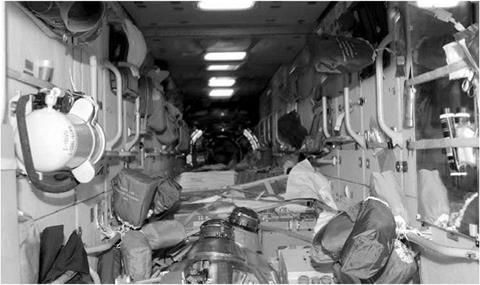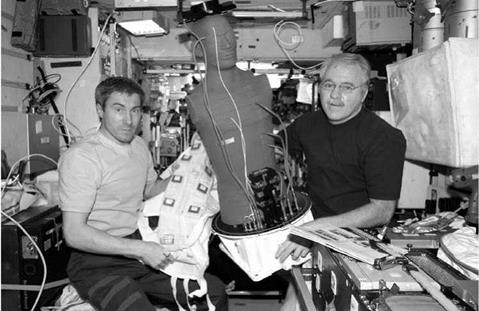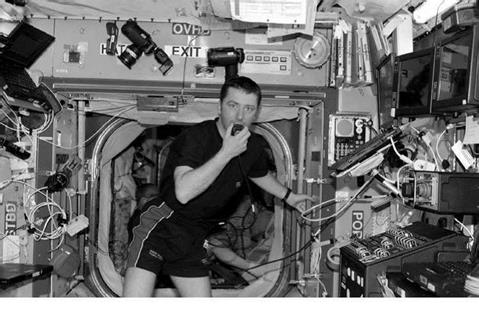MICHAEL GRIFFIN TAKES OVER AT NASA
As March began, Michael Griffin was named as NASA’s new Administrator. Although he had worked for NASA in the past, he was not doing so when he accepted the new position. In the past Griffin had been vocal in his criticism of ISS and his belief that the Shuttle should be grounded before 2010. He made no secret of his dislike of O’Keefe’s plans for an Atlas-V or Delta-IV launched Crew Exploration Vehicle, to be developed in three spirals (phases). In 1989, Griffin had been NASA’s Associate Administrator for Exploration, when President George Bush Senior attempted to send NASA back to the Moon. Now he would oversee the beginning of NASA’s attempts to make President Bush Junior’s Vision for Space Exploration a reality.
In orbit, the Expedition-10 crew spent the next few days unloading the supplies that Progress M-51 carried. Chiao also moved the SSRMS to the positions required for its cameras to view the exterior sites where he and Sharipov would perform work during their second EVA, planned for March 28. He left the SSRMS parked in the best position for the camera to view their work. Although a successful test had been made, the SSRMS was not yet certified to be controlled from the ground. The week was marred by the intermittent performance of the Elektron after it was powered on, on March 2. Sharipov performed several hours of maintenance work on the device, but failed to completely correct the problems. Further attempts at repair, between March 16 and 18, also failed and the unit was powered off until after the crew’s final EVA.
The following week Chiao installed a new heat exchanger in Quest, thereby returning the airlock to full operation. The heat exchanger had been delivered on
Progress M-52. Meanwhile, Sharipov worked in Pirs, preparing it for their forthcoming EVA, planned for March 28. American controllers tested the SSRMS for a second time on March 23. On the same day, Russian controllers fired the station’s thrusters to adjust its orbit in advance of the launch of Soyuz TMA-6. The RPC replaced by the Expedition-9 crew in 2004 failed on March 16, causing CMG-2 to stop working once again. The ISS returned to the minimum attitude control capability of just two working CMGs in the Z-1 Truss. If a third CMG failed, attitude control would be passed to the thrusters on Zvezda. Cables would be re-routed to bypass the faulty RPC during an EVA by the STS-114 crew, after the Shuttle returned to flight later in the year. Two Shuttle astronauts would also replace the CMG that had failed in June 2002. On March 25, the engines on Progress M-52 were used to raise the station’s orbit. The following day a cooling loop panel failed in Pirs. The crew had to replace the panel before their planned EVA could proceed.
Having configured ISS for autonomous flight and sealed all of the internal hatches, Chiao and Sharipov exited the Pirs airlock dressed in Orlan suits at 01: 25, March 28. They collected their tools and Sharipov activated a Russian nano-satellite for later deployment. Their first task was to install three WAL S-band low-gain antennae on the conical section at Zvezda’s ram. The antennae were part of the Proximity Communication Equipment (PCE) to be used by ESA’s ATV. Approximately 2 hours into the EVA, Sharipov stood on a ladder mounted on the exterior of Zvezda and launched the nano-satellite by hand. He released the satellite, which was designed to test new attitude sensors and small satellite control systems, towards the station’s wake.
Russian controllers in Korolev inhibited the station’s thrusters before the two men made their way towards Zvezda’s wake. There, they installed a GPS receiver, which would provide the ATV with its position relative to ISS during rendezvous. They then installed cables for the GPS receiver and photographed the position of another antenna for Russian engineers. They also secured cables along the exterior of the station as they made their way back to Pirs. During this work the station drifted out of alignment and Russian controllers re-activated the thrusters, to resume the correct attitude, as soon as the two men were clear of the area. Having stored their tools, Chiao and Sharipov re-entered Pirs and closed the hatch at 05 : 55, bringing the EVA to an end 1 hour earlier than planned, after 4 hours 30 minutes. Shortly after the EVA ended a series of spikes in vibration were detected in CMG-3, one of the station’s two functioning CMGs. Engineers in Houston began troubleshooting the vibration immediately and ISS was re-positioned so as to minimise demands on the two CMGs.
The crew spent much of the next week preparing the station for re-occupation, stowing tools and cleaning and venting unused oxygen in their Orlan EVA suits into the station’s atmosphere before storing the suits. They also continued stowing equipment that would be returned to Earth in Discovery, during the STS-114 Return to Flight mission, in July. They also tested the cameras that they would use to photograph the approaching Shuttle’s heatshield. The cameras had been delivered on Progress M-52. In the week ending April 8, the Expedition-10 crew began packing for the end of the flight. The station was repressurised using oxygen from the tanks in
|
Figure 52. Expedition-10: Zvezda began to fill with equipment and rubbish during the 3-year period when the Shuttle was grounded. |
|
Figure 53. Expedition-10: note the two Progress docking probes in the foreground of the Zarya image. Only the Shuttle could return bulky items such as these to Earth. Zvezda was equally cramped by this time. |
Progress M-52, while American engineers continued to work on the CMG vibration spikes. Sharipov continued to work with the Elektron system, but the final repair still eluded him. The unit was powered on, on April 13, and was deliberately powered off on April 16, in advance of the Soyuz TMA-6 docking.
|
SOYUZ TMA-6 DELIVERS THE EXPEDITION-11 CREW
|
Soyuz TMA-6 was launched from Baikonur Cosmodrome at 20:46, April 14, 2005. At the time, ISS was over the southern Atlantic Ocean. Following a standard rendezvous the Soyuz docked to Pirs at 22: 20, April 16. After routine pressure checks the hatches between the two vehicles were opened at 00: 45, and the Expedition-11 crew of Krikalev and Phillips entered ISS, where they were greeted by the Expedition-10 crew and given a safety brief. Krikalev and Phillips would complete 6 months on the station, with Krikalev passing 800 days of cumulative time spent in space during the flight and making a Russian record-breaking sixth spaceflight. This would be his third visit to ISS, and his first as Commander. Asked how being Commander differed from being Flight Engineer, he has remarked:
“I think that’s a very subtle issue, because when you fly a crew of two or three, the difference between the Commander and every other crewmember is very subtle… In this case you work as much, and maybe even harder, than your partners because you know more, you have more experience. I think for every Commander safety of the mission, mission success, is a primary goal. Mission success is again a very complicated issue. To say after a flight that a mission was successful, you have to know that all experiments were completed, all the work that was scheduled was done, but most importantly, to know that the crew returned safely to the ground. When you become Commander, you have a responsibility not only for mission success but for your crew, basically for the life of your crew.’’
Phillips had also visited ISS on an earlier Shuttle flight. For him the aims of Expedition-11 were fairly basic, but also vital to the programme:
“For me the first goal is to keep the Station in good shape. That is, basically routine maintenance and contingencies—if something comes up that we have to fix, we need to be able to keep it in good shape. We want to leave it in at least as good shape as we found it. Second is to carry out a program of scientific research. Even with only two people on board, where maintenance is a large piece of our
|
|
|
working day, we still have time to do scientific research. But third, and maybe the most dramatic part of all this, is that we’re going to have the privilege and the challenge of being there when the American Space Shuttles return to flight, hopefully in May of this year.’’
For the next week the two Expedition crews worked together preparing for the Expedition-10 crew’s departure. Safety and equipment briefings were dispersed between sessions unpacking the new Soyuz and preparing the old one for return to Earth. The two crews also worked together in a further attempt to repair the Elektron oxygen generator and the cooling system in Quest. Krikalev and Phillips also had a training period on the SSRMS and received additional briefings on the station’s experiments. Vittori spent much of his time completing the “Endine” suite of 23 ESA, Italian Ministry of Defence, and Italian Chamber of Commerce experiments, before returning to Earth in Soyuz TMA-5, with the Expedition-10 crew. In the meantime, he would become the first ESA astronaut to make a second visit to ISS.
On April 20, Chiao and Phillips worked together to flush the cooling system and replace an umbilical in the Quest, in advance of its return to use during the Expedition-11 occupation. The following day they worked to re-size the EMUs stored in the airlock. Meanwhile, they both worked with Vittori to prepare Soyuz TMA-5 for their return to Earth. On April 22 the two crews joined together for the official change of command ceremony.
During the following week Krikalev worked on the condensate removal system of the Elektron oxygen generation system, which remained off-line after a further 12 hours of work. Krikalev also completed the transfer of water to the station from the docked Progress vehicle. Phillips spent his time installing the Expedition-11 software in the station’s computers. Both men also worked to prepare for the arrival of STS-114.
Chiao, Sharipov, and Vittori separated from ISS in Soyuz TMA-5 at 14: 41, April 24. Sharipov completed the undocking manually in order to reduce the drain on the back-up battery, which had been showing reduced current throughout the Expedition-10 occupation. Soyuz TMA-5 landed at 18: 08, the same day, after a flight lasting 192 days 19 hours 2 minutes. Vittori had been in flight for 9 days 21 hours 21 minutes.














